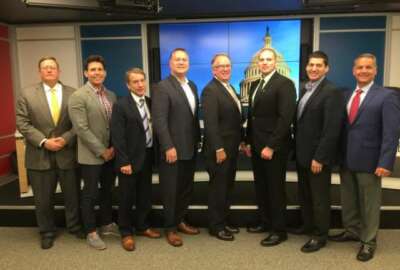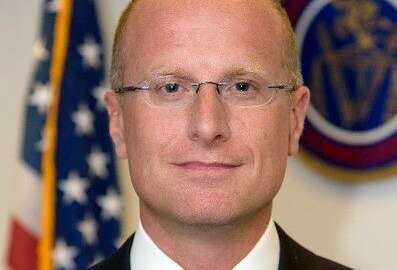 Exclusive
Exclusive  Exclusive
Exclusive Jimmie Adkins, the vice president of federal for Ruckus Networks, said 5G and CBRS will change the way agencies use connected devices and enable a faster, more...
Views from the Corner Office is a new show designed to talk to the private sector leaders that influence and impact the federal market. The goal of this monthly discussion is for federal executives, lawmakers and other industry experts to gain insights and a better understanding into the trends, the challenges and the evaluation of the technology, acquisition and leadership in the federal market by the executives who lead the federal practices of government contractors.

Jimmie Adkins, the vice president of federal for Ruckus Networks, sat down with executive editor Jason Miller at Federal News Network’s studios in Chevy Chase, Maryland.
Here are some excerpts from that discussion.
JM: Is it a good time to be a federal contractor?
JA: If you look at the federal government over the last 20 years, they are always upgrading their technology. It does take a long time. I can tell you that [there are things that] makes it really hard to deal with the federal government. It’s not for the meek. You really got to put your best foot forward when working with the federal government, especially this time of year. I think a lot of the networks were designed 20 years ago, implemented 10 years ago, and they need refreshing. And there are so many different agencies that are on different time levels. So being in the federal government for the last 30 years, for me personally, has been an amazing ride.
JM: It’s interesting you said government contracting is not for the meek. I like that a lot because I think people forget that yes, the government has a lot of positives when you’re a contractor, but there’s the challenges that are great too. When you talk about the changes and the challenges, what are some of the biggest changes you’ve seen?
JA: When I first joined this market, the federal government actually led the development of technology and led the companies. And over the last, I’d say, 10 to 15 years, the commercial industry has caught up. I think the federal government now realizes that. So they’re working closely with the commercial partners, as I like to call them, to bring in those technologies into the federal government. Now, we talked about it being not for the meek. To work with the federal government and as a taxpayer, in order to sell into the federal government, you have to have certifications on your products. That’s a good thing. And along with that, you have to have a secure supply chain. You’ve got to make sure the company is in line with that. So that’s where I talk about it being really difficult to deal with the government, but it’s a good thing.
JM: How much of a cost, how much of a change is it for your company as you’re looking at requests for proposals or requests for information from the government, that includes supply chain as a bigger evaluation factor? What’s a trend you’re seeing around that?
JA: Oh, we’re absolutely seeing that trend. It is a bigger evaluation factor and we’ve noticed that in several of the RFPs that come out. For us it’s something that we do on a daily basis so we just make sure that we tighten down the bolts on all that and we’re able to provide a secure supply chain.
JM: What are maybe some other trends you’re also starting to see that some of your customers are asking about or are interested in?
JA: Yeah, we’re seeing a lot of discussion around 5G and private LTE within a building. 5G is being talked about all the time. It’s coming. It’s supposed to be the savior, and there’s also technologies inside the building that are critical that will help solve a lot of issues by using private LTE.
Right now your cell phone is connected to a service provider — AT&T or Verizon or whomever — but that’s expensive. You have to pay for that. There’s a technology called citizens broadband radio service (CBRS) where you can deploy private LTE. You manage the network. It’s agnostic so it can use anybody’s telephone.
JM: Is it enhanced WiFi or what is it?
JA: Well, it’s a little better than an enhanced WiFi because WiFi is shared and private LTE is dedicated. It is LTE so it’s inherently secure, the quality of services are there and when you get inside these buildings where 5G will have a tough time penetrating those buildings, you can actually have a private LTE for your cell phone.
JM: What do you see from agencies in terms of vendor lock-in? Is it because of the way they’re contracting that sometimes they get hung up on a specific technology or is it the lack of time and resources to go look at what is the art of the possible?
JA: I think it’s both. You’ve got some folks that are going to design what they know. Then there are the others who say, ‘Hey, I’m designing a network to modernize my equipment, and I don’t have time to go out and look at what else is out there.’
JM: Tell me something that you enjoy outside of federal and that most people don’t know about you?
JA: I’ve been in technology my entire life and I drive a pickup truck and I love bass fishing. I could actually catch fish for a living, that’s about the only other thing I’d like to do, join the Bass Master tour.
JM: What kind of truck do you drive? And what’s the biggest fish you’ve ever caught?
JA: The truck is a Ford F-150. The biggest fish I got was 10.1 pounds or a large mouth bass caught in a little private pond behind [NBA center and Washington Wizard] Dwight Howard’s house in Orlando.
Copyright © 2025 Federal News Network. All rights reserved. This website is not intended for users located within the European Economic Area.
Jason Miller is executive editor of Federal News Network and directs news coverage on the people, policy and programs of the federal government.
Follow @jmillerWFED
 Exclusive
Exclusive 
